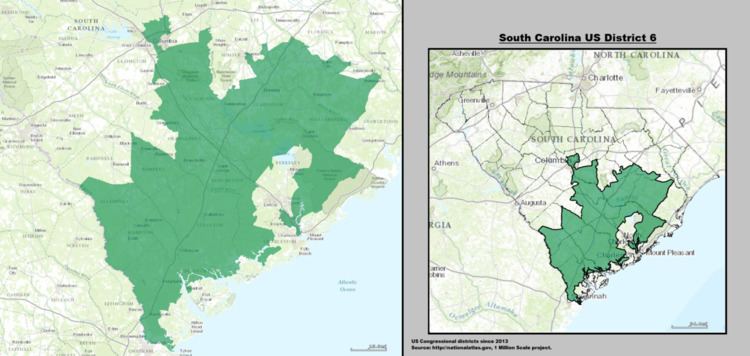Population (2000) 668,670 Cook PVI D+17 | Median income 28,967 | |
 | ||
Ethnicity 40.8% White57.0% Black0.5% Asian1.5% Hispanic0.3% Native American0.1% other | ||
The 6th Congressional District of South Carolina is a congressional district in central and eastern South Carolina. It includes all of Allendale, Bamberg, Barnwell, Clarendon, Colleton, Hampton and Williamsburg counties and parts of Beaufort, Berkeley, Calhoun, Charleston, Dorchester, Georgetown, Orangeburg and Richland counties. The district borders were shifted south in the 2012 redistricting. It lost its share of the North Carolina border, and now takes in part of the area near the South Carolina-Georgia border.
The district was defined in the early 1990s in a deal between state Republicans (mostly white) and Democrats (mostly black) in the South Carolina General Assembly to ensure a majority-black population, known as a majority-minority district. The rural counties of the historical black belt in South Carolina make up much of the district, but it sweeps south to include most of the majority-black precincts in and around Charleston, and sweeps west to include most of the majority-black precincts in and around Columbia. In all of its configurations, its politics have been dominated by black voters in the Columbia and Charleston areas.
Following the Reconstruction era, the white Democratic-dominated legislature passed Jim Crow laws, as well as a new constitution in 1895 that effectively disfranchised blacks, crippling the Republican Party in the state. For most of the next 60 years, South Carolina was essentially a one-party state dominated by the Democrats, and blacks were nearly excluded from the political system.
Demographic and political changes have included the Great Migration (African American) of blacks out of the state during the Jim Crow era in the first half of the 20th century. At the same time, many white Democrats felt chagrin at the national party's greater support of civil rights for blacks from the 1940s onward, and began splitting their tickets in federal elections. After successes of the Civil Rights Movement in gaining passage of federal legislation in the mid-1960s to enforce their constitutional rights and ability to vote, blacks in South Carolina supported national Democratic candidates. This prompted a massive wave of party-switching in which white conservatives began moving into the Republican Party.
Since the late 20th century, South Carolina politics have been very racially polarized. Republicans in South Carolina have been mostly white, and most African Americans in the state continue to support the Democrats. In the 21st century, the 6th is considered the only "safe" Democratic district in the state.
Before 1993, this district included the northeastern part of the state, from Darlington to Myrtle Beach. It was a classic "Yellow Dog" Democratic district; in this configuration it only elected two Republicans, both for a single term. In 2012, the new 7th congressional district was created; it includes much of the territory that was in the 6th for most of the 20th century.
Jim Clyburn, a Democrat and the current Assistant House Minority Leader, has represented this district since first being elected in 1992.
